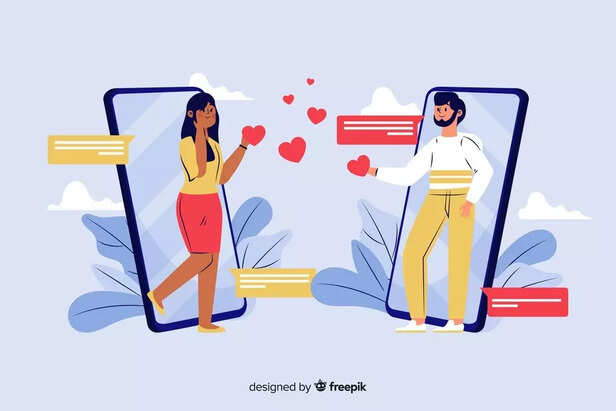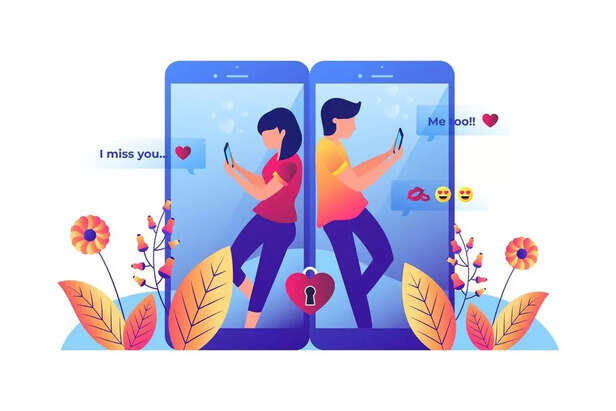Digital Intimacy: How Tech Is Changing Long-Distance Romance
Pranav P | Sun, 11 May 2025
Long-distance love isn’t just about counting days anymore—it’s about counting pings, playlists, and late-night video calls. This article explores how technology is redefining romance across time zones, from FaceTime dates and meme-flirting to virtual cuddles and apps built just for couples. With the right mix of digital tools and real emotional effort, long-distance relationships today are surviving—and thriving—one notification at a time.
( Image credit : Freepik )
Photo:
Once upon a time, long-distance relationships were all about waiting—waiting for letters, for train rides, for international calls that cost half a paycheck. Today? It’s about finding time zones that align and deciding whether to FaceTime in bed or during your lunch break. We’re living in the age of digital intimacy, where WiFi signals carry “I miss you” faster than any postman ever could.
But is tech making long-distance love easier—or just more complicated? Let’s dive deep into the quirky, chaotic, and surprisingly heartwarming ways technology is reshaping the landscape of long-distance relationships.
Before the internet came along, long-distance lovers had to work with what they had: letters that took weeks to arrive, expensive long-distance phone calls, and lots (and lots) of patience. Entire relationships bloomed and faded through paper and pen.
Then came email. Then texting. Then instant messaging. Then FaceTime. And suddenly, distance didn’t mean emotional silence—it meant screens, pings, and the possibility of sharing everyday life across continents.
In short, romance packed its bags and moved online.
Let’s be honest—Zoom fatigue might be real, but video calls are a lifeline for LDRs (long-distance relationships).

It’s not quite a hug, but hey, it’s better than a text saying “I’m tired, goodnight.”
One of the great gifts of tech is the ability to stay constantly connected—sometimes even too much.
In long-distance setups, quick "thinking of you" texts, random voice notes, or even a well-timed meme dump can do wonders for keeping things fun and emotionally vibrant.
Some couples use dedicated apps like Between or Love Nudge to track emotional needs, set “love goals,” or send custom messages and memories. It’s like a digital scrapbook-meets-relationship-therapist.
That said, constant communication can also backfire...
Ironically, having too many ways to connect can sometimes make things more stressful. When you're able to reach your partner 24/7, expectations rise.

Tech can’t replace human presence—but it can magnify both love and insecurity depending on how it's used.
One of the best things couples do in long-distance relationships is create tiny digital rituals. These are often what keep relationships anchored during long stretches apart.
Examples include:
No discussion of long-distance tech-powered romance is complete without talking about the internet itself as a meeting place.
More and more people are meeting through:
Of course, trust becomes a massive factor. When you're far away and relying on pixels, honesty and communication need to be rock solid.
Social media is both a bridge and a battleground in long-distance love.
On one hand, you get to:
Tech isn’t just adapting to long-distance love—it’s designing specifically for it. Here are a few standout apps:
One of the best feelings in a long-distance relationship? That reunion moment. After months of buffering video calls and out-of-sync sleep schedules, seeing each other in person is like every rom-com moment rolled into one.
And strangely enough, the distance often makes couples stronger. You learn to communicate better. You value time more. You build trust with intention.
Technology helps get you there—but it’s the emotional investment behind the tech that really makes long-distance love work.
Studies on long-distance relationships show that couples in LDRs:
But it also demands emotional literacy, digital boundaries, and a bit of patience. After all, not every connection survives just because you can FaceTime. Sometimes, love still needs old-school trust.
So, is tech saving long-distance relationships? Not exactly. It’s changing them—sometimes for better, sometimes for weirder, but always in interesting ways.
From digital cuddles to long-distance playlists, from emoji-laced love notes to VR dates, modern romance has gone high-tech. But at its heart, long-distance love is still about the same old things: communication, effort, honesty, and hope.
Whether you’re thousands of miles apart or just one bad WiFi connection away, if both people are willing to show up (digitally and emotionally), love has a shot. Even through a screen.
Unlock insightful tips and inspiration on personal growth, productivity, and well-being. Stay motivated and updated with the latest at My Life XP.
But is tech making long-distance love easier—or just more complicated? Let’s dive deep into the quirky, chaotic, and surprisingly heartwarming ways technology is reshaping the landscape of long-distance relationships.
From Love Letters to Livestreams: A Quick History
Then came email. Then texting. Then instant messaging. Then FaceTime. And suddenly, distance didn’t mean emotional silence—it meant screens, pings, and the possibility of sharing everyday life across continents.
In short, romance packed its bags and moved online.
Video Calls: The Long-Distance Love Language

flat-infographics-man-woman-acquaintance-social-network
( Image credit : Freepik )
- FaceTime dates are the new dinner and a movie.
- Netflix + Zoom = movie nights with shared laughter (and a few buffering issues).
- Some couples even fall asleep on video calls—like a virtual sleepover, minus the snoring in real-time.
It’s not quite a hug, but hey, it’s better than a text saying “I’m tired, goodnight.”
Texting, Voice Notes, and Memes: The Casual Closeness
In long-distance setups, quick "thinking of you" texts, random voice notes, or even a well-timed meme dump can do wonders for keeping things fun and emotionally vibrant.
Some couples use dedicated apps like Between or Love Nudge to track emotional needs, set “love goals,” or send custom messages and memories. It’s like a digital scrapbook-meets-relationship-therapist.
That said, constant communication can also backfire...
When Tech Becomes Too Much

dating-app-concept
( Image credit : Freepik )
- Why didn’t they text back right away?
- Were they online but ignoring me?
- Are we drifting or just dealing with bad WiFi?
Tech can’t replace human presence—but it can magnify both love and insecurity depending on how it's used.
The Joy of Digital Rituals
Examples include:
- Daily good morning/night texts
- A shared Google calendar for virtual dates
- Weekly "cook together while on video" nights
- Playing games together on platforms like Steam or mobile apps
- Writing letters by hand, then reading them together over Zoom
Time Zones, Trust, and TikTok Love Stories
More and more people are meeting through:
- Dating apps with global settings (Tinder Passport, Bumble, Hinge)
- Gaming platforms like Discord or Fortnite
- Social media—yes, couples who met in Instagram DMs are a real thing
- Even through TikTok comment sections and live streams
Of course, trust becomes a massive factor. When you're far away and relying on pixels, honesty and communication need to be rock solid.
The Double-Edged Sword of Social Media
On one hand, you get to:
- See what your partner’s up to
- Tag each other in cute stuff
- Celebrate milestones publicly
- Misinterpreting posts becomes easy
- Comparisons creep in (“Why isn’t my partner posting about me like others do?”)
- It can create pressure to perform your relationship instead of simply living it
Love Gets an Upgrade: Apps Built for LDRs
- Couple – A private messaging app for two
- Between – Save shared memories, send notes, track anniversaries
- Love Nudge – Based on love languages, it helps couples express care in personalized ways
- Rave – Watch movies together in sync
- PillowTalk – Lets you hear your partner’s heartbeat remotely (yes, it’s real)
The Return to Physical Presence: Making the Distance Worth It
And strangely enough, the distance often makes couples stronger. You learn to communicate better. You value time more. You build trust with intention.
Technology helps get you there—but it’s the emotional investment behind the tech that really makes long-distance love work.
Can Digital Love Last? Science Says… Yes (Mostly)
- Often communicate more deeply and frequently
- Develop stronger emotional bonds due to intentional conversations
- Are just as likely (sometimes more) to last as geographically close couples
But it also demands emotional literacy, digital boundaries, and a bit of patience. After all, not every connection survives just because you can FaceTime. Sometimes, love still needs old-school trust.
Conclusion: Love in the Time of WiFi
From digital cuddles to long-distance playlists, from emoji-laced love notes to VR dates, modern romance has gone high-tech. But at its heart, long-distance love is still about the same old things: communication, effort, honesty, and hope.
Whether you’re thousands of miles apart or just one bad WiFi connection away, if both people are willing to show up (digitally and emotionally), love has a shot. Even through a screen.
Unlock insightful tips and inspiration on personal growth, productivity, and well-being. Stay motivated and updated with the latest at My Life XP.










